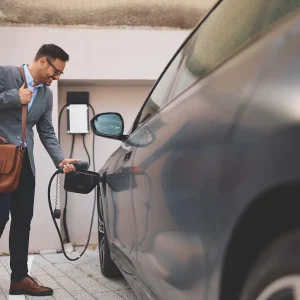“We have a vision that there will be a Pod Point everywhere that you park for an hour or more,” Erik Fairbairn, CEO of charging point company Pod Point ambitiously told BusinessCar.
In the seven years that it has been operating, the business has installed around 22,000 charging units to the start of 2016, with another 15,000 expected to be added by the end of this year.
Of those, around 2000 form Pod Point’s own public charging network, Open Charge, up to five thousand are sited at business addresses, and the remaining 15,000 units are located at customer homes.
According to Fairbairn, each subsequent year almost matches the total sales history of the company: “We’ve got one of those super-duper growth cycles which is in line with the rising number of electric vehicles coming to the market.”
The workplace-charging hurdle
Pod Point is trying to encourage the uptake of workplace charging, and, despite European Union competition laws prohibiting Government subsidies for keen businesses, Fairbairn says there are two ways to do this.
First is the more traditional fashion of “talking to environmental people and then fleet people and saying ‘would you like these?'” he said.
The second is the somewhat less conventional staff-campaigning approach, which Fairbairn sees as very important in increasing the number of workplace chargers.
He says: “We quite often find that when someone gets an electric vehicle they do campaign quite loudly and strongly to their workplace to put in a charging point infrastructure.
“So, we often find that what to us is a private individual buying a charging point actually represents someone who can help us get their employer up to speed,” he continues. “We see a network effect that starts when we sell a charging point to one person, and they then build the network by getting one into their workplace or talking to their local supermarket and all the other things that are required with electric vehicles.”
Educating EV drivers
Pod Point was recently named as the ‘preferred charging supplier’ for Volkswagen and Volvo. So, when someone buys a plug-in or electric vehicle from these manufacturers, they are “introduced to us [and we] are able to manage the whole of the charging process”.
Fairbairn’s team will – in advance of the vehicle being delivered – install a charger at the customer’s home and introduce them to workplace and public charging networks. “It means the person can be fully briefed on everything that they need to know about charging,” he says.
In keeping with his aim of there being chargers everywhere motorists park for an hour or more, Fairbairn tells BusinessCar it is “vital” that new EV owners can have what he calls the “right” charging infrastructure
at work and at home, with access to a public network.
“I think that most of the other car manufacturers see the direction being taken by VW and Volvo as fundamental – you can’t sell a plug-in hybrid and not have someone helping that customer out with their charging infrastructure,” he adds. “I think as the market matures and you get more momentum behind it, automotive manufacturers will get behind it and say ‘this is a really significant part of customer experience and we need someone to do it’.
The future of charging
Fairbairn believes there is a need for “an enormous number of charging points everywhere” in future in order to allow electric vehicles to be able to charge when they’re parked.
“Electric vehicles are always going to charge at slightly slower rates [than refilling petrol or diesel vehicles], which lends itself to charging when the car is parked,” he says.
“You’ll have a chargepoint at your home, so that when you’re asleep your car is charging, then at work you’ll have workplace charging and when you’re at Sainsbury’s. It’ll be the same at the leisure centre and the rest of [the time] when you’re parked.”
However, Fairbairn believes the level of investment needed to achieve this dream is beyond what the Government will be prepared to put in. “It’s got to be a commercial roll-out of chargepoints,” he reckons.
Pod Point and fleet
The fleet industry will be “massive” to the future of the company, according to Fairbairn. He expects that half of its business will have a fleet element to it in future, as it aims to place a charging point whenever vehicles are parked.
“We need to set a bunch of annual objectives that lead us up to that over a period of 20 years, and it is all about building up a network of charging points that will roll proportionally slightly ahead of the roll out of electric vehicles – so we always try to have more charging infrastructure out there than there are electric vehicles crying out for it,” he says.
“We see it [fleet] as a really large growth area – you’re not dealing with a single individual needing a chargepoint, you can be dealing with companies with a few thousand vehicles and [this] needs a joined-up fully managed solution that does the charging for their entire fleet,” he concludes.





